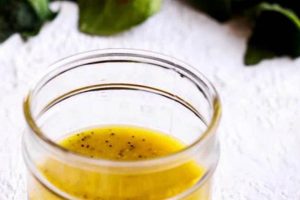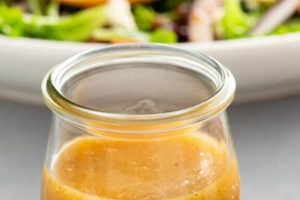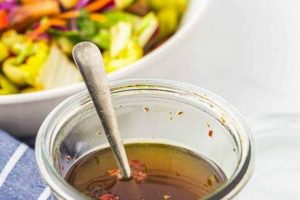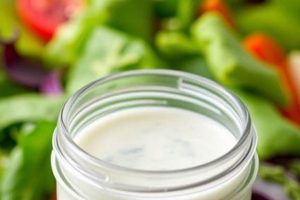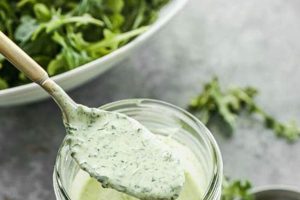A blend of ingredients combined to flavor and coat cooked potatoes forms the foundation of this culinary staple. Variations abound, from simple mixtures of mayonnaise and mustard to more complex creations incorporating vinegar, herbs, spices, and other flavoring agents. A classic example might include mayonnaise, yellow mustard, celery seed, diced onion, and hard-boiled eggs.
The right combination of ingredients elevates boiled potatoes into a flavorful and satisfying dish, suitable for picnics, potlucks, and backyard barbecues. Its versatility allows for customization based on personal preferences and regional traditions, making it a perennially popular side dish. Historically, the concept evolved alongside mayonnaise-based sauces, gaining traction as refrigeration became more commonplace.
This discussion will explore the core components of successful emulsions, explore a range of flavor profiles, and offer guidance on techniques for achieving optimal texture and taste.
Tips for Creating Exceptional Potato Salad Dressing
Achieving a well-balanced and flavorful potato salad dressing requires attention to detail and an understanding of complementary flavors. These tips offer guidance for creating dressings that enhance, rather than overpower, the potatoes.
Tip 1: Balance Tang and Richness. The ideal dressing balances acidity and richness. Vinegar or lemon juice provide necessary tang, while mayonnaise or sour cream contribute creamy richness. Achieving the right balance prevents the dressing from being overly heavy or excessively tart.
Tip 2: Seasoning Beyond Salt and Pepper. While salt and pepper are essential, exploring other seasonings can significantly elevate the flavor profile. Consider incorporating paprika, cayenne pepper, garlic powder, onion powder, or dried herbs such as dill or chives.
Tip 3: Fresh Herbs for Brightness. Fresh herbs contribute vibrancy and complexity. Finely chopped parsley, dill, chives, or tarragon add a refreshing element and complement the other flavors.
Tip 4: Textural Considerations. Incorporating finely diced celery, red onion, or pickles adds a pleasant textural contrast to the creamy dressing and the soft potatoes.
Tip 5: Mindful Ingredient Incorporation. Ingredients should be added gradually, tasting and adjusting seasonings as needed. This prevents over-seasoning and ensures a harmonious blend of flavors.
Tip 6: Rest and Chill. Allowing the dressing to rest, preferably chilled, for at least 30 minutes allows the flavors to meld and deepen. This enhances the overall taste experience.
Tip 7: Proper Potato Preparation. The potatoes themselves play a crucial role. Ensure they are cooked until tender but not mushy, and allow them to cool slightly before dressing to prevent the dressing from thinning.
By following these guidelines, one can consistently create dressings that transform simple boiled potatoes into a memorable and satisfying culinary experience.
These insights into dressing preparation provide a foundation for exploring a variety of potato salad recipes and techniques.
1. Base (mayonnaise, yogurt)
The base of a potato salad dressing provides the foundational texture and flavor, significantly influencing the overall character of the dish. Mayonnaise, a classic choice, contributes a rich, creamy texture and tangy flavor. Its emulsified nature helps coat the potatoes evenly, creating a smooth and cohesive salad. Yogurt, a lighter alternative, offers a subtly tangy and refreshing counterpoint to the richness of the potatoes. Choosing between mayonnaise and yogurt, or even combining them, allows for customization based on desired flavor profiles and dietary preferences. For example, a classic American-style potato salad typically relies on mayonnaise, contributing to its creamy, slightly tangy character. Conversely, potato salads incorporating yogurt often feature lighter, brighter flavor profiles, sometimes complemented by fresh herbs and lemon.
The selection of the base ingredient influences not only the flavor but also the overall mouthfeel and richness of the salad. Mayonnaise-based dressings tend to be richer and creamier, while yogurt-based dressings offer a lighter, more refreshing experience. The fat content of the base also plays a role in how the dressing coats the potatoes and how the flavors meld. Furthermore, the base interacts with other ingredients, such as vinegar and mustard, influencing the balance of tanginess and richness in the final product. Practical applications of this understanding include tailoring the base to specific dietary needs, such as using low-fat yogurt for a healthier option, or choosing vegan mayonnaise for plant-based diets.
In summary, the base of a potato salad dressing functions as the canvas upon which other flavors and textures are built. A careful selection of mayonnaise, yogurt, or a combination thereof, allows for control over the final character of the dish, enabling cooks to create potato salads ranging from classic and creamy to light and refreshing. Understanding this foundational element is crucial for crafting potato salads that meet specific taste preferences and dietary requirements. This principle extends to variations using sour cream or other emulsified bases, each impacting the final result.
2. Tang (vinegar, mustard)
The element of “tang” plays a crucial role in a successful potato salad dressing recipe, providing a necessary counterpoint to the richness of the base and the starchiness of the potatoes. This acidity, often derived from vinegar or mustard, brightens the overall flavor profile and prevents the dish from feeling heavy or bland. Understanding the nuances of incorporating tang is essential for creating a well-balanced and flavorful potato salad.
- Types of Vinegar
Various vinegars contribute distinct flavor nuances. Apple cider vinegar imparts a mild, fruity acidity, while white vinegar offers a sharper, cleaner tang. Red wine vinegar introduces a subtle complexity, and distilled white vinegar provides a neutral, purely acidic note. The choice of vinegar depends on the desired flavor profile and the other ingredients in the dressing.
- Mustard Varieties
Mustard, another source of tang, adds both flavor and texture. Yellow mustard provides a mild, familiar tang, while Dijon mustard offers a more robust and complex flavor. Stone-ground or whole-grain mustard contributes a textured element in addition to its pungent flavor. The choice of mustard complements and interacts with the chosen vinegar, adding layers of complexity.
- Balancing Tang and Richness
The balance between tang and richness is paramount. Too much acidity can make the salad taste overly sharp, while too little can result in a bland and heavy dish. Careful consideration of the base (mayonnaise, yogurt) and the chosen vinegar and mustard allows for precise control over this balance. Taste-testing and adjusting the amounts of these ingredients ensures a harmonious flavor profile.
- Interaction with Other Ingredients
The tangy elements interact with other components of the dressing, such as herbs, spices, and sweeteners. The acidity can enhance the flavors of fresh herbs like dill or parsley, while also balancing the sweetness of added sugar or relish. Understanding these interactions is key to creating a complex and well-rounded flavor profile.
The careful interplay of vinegar and mustard provides the essential acidic counterpoint that elevates potato salad from simple to exceptional. By understanding the nuances of these ingredients and their interactions, one can create a dressing that perfectly complements the potatoes and other ingredients, resulting in a balanced and flavorful dish. This careful consideration of tang is a hallmark of successful potato salad preparation.
3. Seasoning (salt, pepper, herbs)
Seasoning forms the backbone of flavor complexity in potato salad dressing. Beyond the foundational elements of salt and pepper, a thoughtful approach to herbs and spices elevates the dressing from basic to nuanced. Strategic seasoning choices amplify the inherent flavors of the other ingredients, creating a well-rounded and satisfying culinary experience.
- Salt’s Foundational Role
Salt is essential, enhancing the inherent flavors of the potatoes and other dressing components. It acts not only as a flavor enhancer but also as a critical element in balancing the tanginess of vinegar or mustard. Proper salting is essential for a well-rounded flavor profile. Inadequate salting can result in a flat, underwhelming dressing, while over-salting can overwhelm the other flavors.
- Pepper’s Complexity
Pepper adds depth and complexity. Freshly ground black pepper provides a subtle heat and a complex aroma, complementing the other spices and herbs. White pepper offers a cleaner, less assertive heat. The choice between black and white pepper, or a combination of both, depends on the overall flavor profile desired.
- Fresh Herbs’ Vibrancy
Fresh herbs contribute brightness and freshness. Dill, parsley, chives, and tarragon are common choices, each offering a unique flavor profile. Dill adds a slightly tangy, herbaceous note, while parsley provides a clean, fresh flavor. Chives contribute a subtle oniony flavor, and tarragon offers a distinctive anise-like aroma. Fresh herbs should be added towards the end of the preparation process to retain their vibrant flavors and aromas.
- Dried Spices’ Depth
Dried spices offer deeper, more concentrated flavors. Paprika, celery seed, onion powder, and garlic powder can enhance the complexity of the dressing. Paprika adds a subtle smokiness and a warm, earthy flavor, while celery seed provides a characteristic savory note. Onion and garlic powder contribute pungent, savory notes, enhancing the overall flavor depth.
The interplay of salt, pepper, herbs, and spices determines the final character of the potato salad dressing. A balanced approach, considering the interplay of these elements, ensures a flavorful and well-rounded dressing that complements the potatoes and other ingredients. The careful selection and application of seasoning distinguish a truly exceptional potato salad from a mediocre one.
4. Texture (celery, onion)
Textural contrast contributes significantly to the overall enjoyment of potato salad. The creamy dressing and soft potatoes benefit from the addition of crisp, crunchy elements. Incorporating ingredients like celery and onion introduces these textural variations, creating a more dynamic and satisfying sensory experience.
- Celery’s Crispness
Celery’s fibrous stalks offer a refreshing crunch, contrasting with the softer textures of the potatoes and dressing. Its subtle, slightly vegetal flavor complements the other ingredients without overpowering them. Finely diced celery distributes evenly throughout the salad, ensuring each bite contains this textural element. The crispness of celery also holds up well in the dressing, maintaining its textural integrity even after chilling.
- Onion’s Pungency and Bite
Onions, whether red, white, or yellow, introduce both textural and flavor complexity. Their sharp, pungent flavor balances the richness of the dressing, while their crisp texture adds a pleasant bite. Finely diced or thinly sliced onions distribute well throughout the salad. The intensity of the onion flavor can be adjusted by choosing milder varieties or by briefly soaking the chopped onions in cold water to mellow their pungency.
- Other Textural Options
Beyond celery and onion, other ingredients can contribute textural variety. Chopped pickles offer a tangy crunch, while bell peppers introduce a subtle sweetness and a slightly firm texture. Water chestnuts provide a unique, crisp-tender texture. These additions expand the textural possibilities, offering diverse options for customizing the salad.
- Balancing Texture and Flavor
The choice of textural ingredients should complement the overall flavor profile of the dressing. For example, a dill-based dressing might pair well with the crispness of cucumber, while a mustard-based dressing might benefit from the addition of chopped pickles. The balance between textural and flavor elements is key to a well-rounded and enjoyable potato salad experience.
The interplay of textures within potato salad elevates it from a simple side dish to a more complex and satisfying culinary creation. The considered inclusion of ingredients like celery and onion, or other textural additions, adds depth and interest to each bite, enhancing the overall enjoyment of the dish. This attention to texture distinguishes a well-crafted potato salad from a more basic preparation.
5. Balance (flavor harmony)
Balance, or flavor harmony, represents a critical aspect of a successful potato salad dressing recipe. It refers to the careful interplay of different flavor componentstanginess, richness, sweetness, saltiness, and spicinesscreating a unified and pleasing whole. Without balance, individual flavors can clash, resulting in a dressing that is overly tart, excessively sweet, or bland and unmemorable. A harmonious dressing, however, allows each ingredient to contribute to the overall flavor profile without overpowering the others.
Achieving balance requires a nuanced understanding of how different ingredients interact. The tanginess of vinegar, for example, must be balanced by the richness of mayonnaise or yogurt. The sweetness of added sugar or relish should be tempered by the saltiness of the dressing and the inherent starchiness of the potatoes. Spices and herbs, while adding complexity, should be used judiciously to avoid overwhelming the other flavors. For instance, a dressing with too much mustard can overpower the subtle flavors of fresh dill or chives. Conversely, a dressing lacking sufficient acidity can taste flat and heavy, failing to complement the potatoes.
Practical applications of this understanding are numerous. When developing a potato salad dressing recipe, one must consider the interplay of all ingredients. Tasting and adjusting throughout the process is crucial. Start with a base recipe and gradually incorporate additional flavors, evaluating the balance at each stage. If the dressing is too tangy, a touch of sweetness or a richer base might be needed. If it’s too bland, consider adding more salt, spices, or herbs. Achieving balance is an iterative process, requiring careful attention to detail and a willingness to experiment. The ultimate goal is a harmonious flavor profile where each ingredient contributes to a cohesive and delicious whole, enhancing the overall enjoyment of the potato salad.
6. Freshness (high-quality ingredients)
The quality of ingredients directly impacts the overall flavor and enjoyment of potato salad. Fresh, high-quality components contribute significantly to a superior final product. Utilizing such ingredients elevates the taste and textural experience, distinguishing exceptional potato salad from mediocre versions. This emphasis on freshness underscores the importance of ingredient selection in crafting a truly delightful dish.
- Mayonnaise Selection
Opting for high-quality mayonnaise, preferably one made with real eggs and oil, contributes a richer, creamier texture and a more nuanced flavor compared to lower-quality alternatives. This choice enhances the overall mouthfeel and flavor profile of the dressing. The difference is often noticeable in the overall richness and depth of flavor the dressing imparts.
- Fresh Herbs vs. Dried
Fresh herbs offer a brighter, more vibrant flavor compared to dried counterparts. Their aromatic oils contribute significantly to the overall sensory experience. While dried herbs offer convenience, fresh herbs elevate the flavor profile considerably. The difference is particularly noticeable in delicate herbs like dill and chives. Freshly chopped herbs provide a burst of flavor that enhances the overall freshness of the salad.
- Potato Quality and Preparation
Selecting firm, unblemished potatoes and employing proper cooking techniques ensures optimal texture and flavor. Overcooked potatoes become mushy and absorb less dressing, compromising the overall texture and flavor balance. Freshly cooked potatoes, properly handled, provide the ideal canvas for the dressing, allowing its flavors to shine through. This also extends to proper storage of potatoes before cooking, preventing off-flavors and ensuring optimal texture.
- Vinegar and Mustard Considerations
Utilizing high-quality vinegar and mustard contributes nuanced acidity and complexity to the dressing. Freshly prepared mustards often contain a broader spectrum of flavor compounds compared to mass-produced versions. Similarly, higher-quality vinegars offer more complex flavor profiles. These choices, while seemingly minor, can significantly impact the overall balance and depth of flavor in the final dish. For instance, a locally crafted apple cider vinegar might offer subtle fruit notes absent in a standard commercial variant.
Prioritizing fresh, high-quality ingredients demonstrably improves the flavor, texture, and overall enjoyment of potato salad. Ingredient selection significantly influences the final product, illustrating the critical connection between freshness and a superior culinary outcome. The emphasis on quality ingredients underscores a commitment to excellence in creating a truly exceptional dish.
7. Chill time (flavor development)
Chilling time plays a crucial role in the development of flavor complexity within potato salad dressing. Allowing the mixture to rest in a refrigerated environment facilitates the melding and harmonization of individual ingredients. This period allows the flavors to mature and deepen, resulting in a more cohesive and nuanced flavor profile. Understanding the impact of chill time is essential for maximizing the flavor potential of potato salad dressing.
- Flavor Integration
Chilling allows the diverse flavors within the dressingfrom the tanginess of vinegar to the richness of mayonnaise and the herbaceous notes of spices and herbsto fully integrate. This integration process results in a more balanced and harmonious flavor profile, where individual components no longer stand out, but rather contribute to a unified whole. The initially disparate flavors meld together, creating a more complex and nuanced taste.
- Reduction of Harshness
Certain ingredients, like raw onions or strong vinegars, can possess a harshness when initially incorporated into the dressing. Chilling mellows these sharp notes, allowing their flavors to integrate more smoothly with the other ingredients. This mellowing effect contributes to a more balanced and palatable final product, where the sharpness of individual components is tempered and integrated into the overall flavor profile. The chill time effectively refines the flavor balance, creating a more harmonious result.
- Enhanced Texture
Chilling also positively impacts the texture of the potato salad dressing. The cooling process allows the emulsion to further stabilize, resulting in a thicker, creamier consistency. This improved texture enhances the cling of the dressing to the potatoes, ensuring each bite is coated evenly with flavor. Furthermore, the chilled temperature enhances the perceived freshness and crispness of textural elements like celery and onion.
- Optimal Flavor Perception
Serving potato salad chilled enhances the perception of its flavors. The cooler temperature accentuates the tanginess of the dressing and the refreshing qualities of the other ingredients. This heightened sensory experience contributes significantly to the overall enjoyment of the dish. The chilled temperature also provides a welcome contrast to warmer main dishes, making the potato salad a refreshing complement to the overall meal.
The benefits of chill time extend beyond mere convenience. It represents a crucial step in flavor development, textural enhancement, and optimal flavor perception. By allowing sufficient chill time, the individual components of the potato salad dressing transform into a cohesive and flavorful whole, significantly enhancing the overall culinary experience. This understanding highlights the importance of incorporating chill time as an integral part of any potato salad dressing recipe.
Frequently Asked Questions
The following addresses common inquiries regarding the preparation and nuances of potato salad dressing.
Question 1: What is the ideal ratio of mayonnaise to vinegar in a classic potato salad dressing?
The ideal ratio depends on personal preference, but a general guideline is three parts mayonnaise to one part vinegar. This balance allows the richness of the mayonnaise to be complemented by the tanginess of the vinegar without becoming overly acidic. Adjustments can be made based on the specific type of vinegar used; milder vinegars may require slightly higher proportions.
Question 2: Can other acidic ingredients be substituted for vinegar?
Lemon juice or other citrus juices offer viable alternatives to vinegar, providing a different yet complementary acidity. The specific flavor profile of the citrus fruit should be considered, ensuring it harmonizes with the other dressing components. For instance, lime juice might complement a cilantro-based dressing, while lemon juice pairs well with dill or chives.
Question 3: How can one prevent potato salad dressing from becoming too watery?
Ensuring the potatoes are adequately cooled before dressing prevents excess moisture from thinning the dressing. Additionally, using a thicker consistency mayonnaise can improve the dressing’s stability. Adding a small amount of cooked, mashed potato to the dressing can also help absorb excess liquid and create a creamier texture.
Question 4: What are the best potato varieties for potato salad?
Waxy potato varieties, such as red potatoes or Yukon Golds, hold their shape well after cooking, making them ideal for potato salad. These varieties resist becoming mushy, ensuring a pleasant textural contrast with the dressing. Avoid russet potatoes, as they tend to crumble after cooking.
Question 5: How long can potato salad be safely stored?
Potato salad should be refrigerated promptly and consumed within three to five days. Proper refrigeration prevents bacterial growth and maintains the quality of the ingredients. Always use clean utensils when serving to avoid cross-contamination.
Question 6: How can the flavor of potato salad dressing be enhanced beyond basic ingredients?
Incorporating fresh herbs, spices, and other flavoring agents adds depth and complexity. Consider adding chopped fresh dill, chives, or parsley for brightness. Spices like paprika, celery seed, or mustard powder introduce nuanced flavors. A touch of sweetness, from a small amount of sugar or sweet pickle relish, can balance the tanginess and add another layer of flavor.
Careful consideration of these frequently asked questions provides a comprehensive understanding of potato salad dressing preparation, storage, and flavor optimization. These insights contribute to consistently successful outcomes and enhance overall enjoyment of this culinary staple.
This FAQ section provides a foundation for further exploration of recipe variations and techniques.
Conclusion
Careful consideration of the components within a potato salad dressing recipethe base, tangy elements, seasonings, textural additions, and the crucial balance among themyields a superior culinary outcome. Ingredient quality and proper chilling techniques further enhance the final product. Understanding these elements allows for informed choices, transforming a simple mixture into a cohesive and flavorful dressing that elevates the humble potato salad to a delightful culinary experience.
Mastery of these principles allows for adaptation and innovation, encouraging exploration of diverse flavor profiles and personalized variations. The potential for culinary creativity within the seemingly simple framework of potato salad dressing remains vast, inviting continued exploration and refinement of this classic dish.


